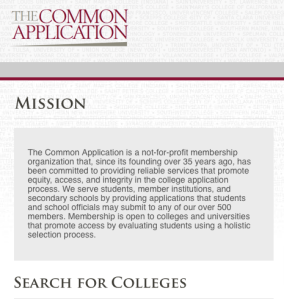 We’ve all heard the stories about a broken website that was overwhelmed with visitors and was inadequately tested. But unless you have a high school senior in your home, you may not have heard about another website besides the much-flogged HealthCare.gov (that I and many others wrote about). I am talking about the common application website for college admissions.
We’ve all heard the stories about a broken website that was overwhelmed with visitors and was inadequately tested. But unless you have a high school senior in your home, you may not have heard about another website besides the much-flogged HealthCare.gov (that I and many others wrote about). I am talking about the common application website for college admissions.
About 500 out of the nation’s several thousand colleges and universities support this site, which allows them to eliminate paper student admissions applications. The idea dates back to when I was applying for college, when a common paper-based application was put in use. Later it went digital. Trouble is, the latest version of the common app is seriously broken and has prevented many kids from applying to the colleges of their choice. Given the high stakes involved, it is a serious problem.
The best press coverage about the breakdown has been from Nancy Griesemer in examiner.com where she lists work-arounds for the students and chronicles the troubles of CommonApp, as it is known, has gone through since they did a major overhaul this past summer. “The implementation has been terrible,” one college admissions IT director told me. “Applicants have had difficulties in creating and completing their application, school officials have had problems in submitting transcripts and recommendations, and major changes in how the information is delivered to colleges have happened without sufficient time for schools to adapt and test their systems. We needed more lead time.”
This director isn’t alone: many college admissions officers vented their frustrations at their annual meeting last month in Toronto, where some said they couldn’t get satisfactory answers from the CommonApp staff. There were lots of things that should have been caught before being implemented. For example, a payment processor routine that takes two days to send a confirmation receipt, so many kids are paying multiple times. Or a signature page that is so well hidden that students didn’t find it to sign their apps. As a result, their apps are never delivered to the college. Or those all-important student essays turn into gibberish under some circumstances, due to a faulty text import routine. Supposedly, these issues are being fixed literally right now. It makes the HealthCare.gov site look like a well-run place.
The CommonApp processes more than a million applications a year, and is the only application method for about 300 schools. If you are applying early decision to one of these, you are in a tough situation as the decision deadlines are approaching.
Some 50 others are using another online process called the Universal College App, including most recently Princeton. This process hasn’t been plagued with problems.
It is hard enough for high school seniors to figure out the college game without having to become unwitting software UI and QC testers. CommonApp needs to fix its code fast, and be more transparent about its problems in the future.
The old adage still applies – “To err is human. To really f%*#k up takes a computer.”
The problems aren’t limited to students. Those who are writing recommendations for students are finding it difficult to submit them as well. After about an hour of trying yesterday, my wife gave up….